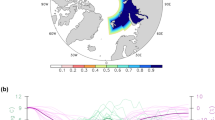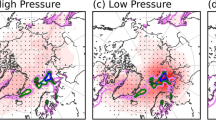Abstract
The impact of a reduced Arctic sea ice cover on wintertime extratropical storminess is investigated by conducting atmospheric general circulation model (AGCM) experiments. The AGCM ECHAM5 is forced by the present and a projected future seasonal cycle of Arctic sea ice. In the experiment with projected sea-ice concentrations significant reductions in storminess were found during December and January in both midlatitudes and towards the Arctic. However, a substantially larger reduction in extratropical storminess was found in March, despite a smaller change in surface energy fluxes in March than in the other winter months. The projected decrease in storminess is also related to the negative phase of the North Atlantic Oscillation (NAO). The March response is consistent with a forcing from transient and quasi-stationary eddies associated with negative NAO events. The greater sensitivity to sea-ice anomalies in late winter sets this study apart from earlier ones.





Similar content being viewed by others
References
Alexander MA, Bhatt US, Walsh JE, Timlin MS, Miller JS, Scott JD (2004) The atmospheric response to realistic Arctic sea ice anomalies in an AGCM during winter. J Clim 17:890–905
Bengtsson L, Hodges KI, Roeckner E (2006) Storm tracks and climate change. J Clim 19:3518–3543
Chang EKM, Lee SY, Swanson KL (2002) Storm track dynamics. J Clim 15:2163–2183
Deser C, Magnusdottir G, Saravanan R, Phillips A (2004) The effects of North Atlantic SST and sea ice anomalies on the winter circulation in CCM3. Part II: Direct and indirect components of the response. J Clim 17:877–889
Deser C, Tomas RA, Peng SL (2007) The transient atmospheric circulation response to North Atlantic SST and sea ice anomalies. J Clim 20:4751–4767
Edmon HJ, Hoskins BJ, McIntyre ME (1980) Eliassen-Palm cross-sections for the troposphere. J Atmos Sci 37:2600–2616
Eisenman I, Untersteiner N, Wettlaufer JS (2007) On the reliability of simulated Arctic sea ice in global climate models. Geophys Res Lett 34:L10501
Held IM (1993) Large-scale dynamics and global warming. Bull Am Meteorol Soc 74:228–241
Kushnir Y, Robinson WA, Blade I, Hall NMJ, Peng S, Sutton R (2002) Atmospheric GCM response to extratropical SST anomalies: synthesis and evaluation. J Clim 15:2233–2256
Kvamstø NG, Skeie P, Stephenson DB (2004) Impact of Labrador sea-ice extent on the North Atlantic Oscillation. Int J Climatol 24:603–612
Limpasuvan V, Hartmann DL (2000) Wave-maintained annular modes of climate variability. J Clim 13:4414–4429
Lorenz DJ, Hartmann DL (2003) Eddy-zonal flow feedback in the Northern Hemisphere winter. J Clim 16:1212–1227
Magnusdottir G, Deser C, Saravanan R (2004) The effects of North Atlantic SST and sea ice anomalies on the winter circulation in CCM3. Part I: Main features and storm track characteristics of the response. J Clim 17:857–876
Peng SL, Robinson WA (2001) Relationships between atmospheric internal variability and the responses to an extratropical SST anomaly. J Clim 14:2943–2959
Peng SL, Robinson WA, Hoerling MP (1997) The modeled atmospheric response to midlatitude SST anomalies and its dependence on background circulation states. J Clim 10:971–987
Pinto JG, Ulbrich U, Leckebusch GC, Spangehl T, Reyers M, Zacharias S (2007) Changes in storm track and cyclone activity in three SRES ensemble experiments with the ECHAM5/MPI-OM1 GCM. Clim Dyn 29:195–210
Rayner NA, Parker DE, Horton EB, Folland CK, Alexander LV, Rowell DP, Kent EC, Kaplan A (2003) Global analyses of sea surface temperature, sea ice, and night marine air temperature since the late nineteenth century. J Geophys Res Atmos 108:4407
Singarayer JS, Bamber JL, Valdes PJ (2006) Twenty-first-century climate impacts from a declining Arctic sea ice cover. J Clim 19:1109–1125
Stroeve J, Holland MM, Meier W, Scambos T, Serreze M (2007) Arctic sea ice decline: faster than forecast. Geophys Res Lett 34:L09501
Ulbrich U, Pinto JG, Kupfer H, Leckebusch GC, Spangehl T, Reyers M (2008) Changing Northern Hemisphere storm tracks in an ensemble of IPCC climate change simulations. J Clim 21:1669–1679
Wallace JM, Lim GH, Blackmon ML (1988) On the relationship between cyclone tracks, anticyclone tracks and baroclinic wave guides. J Atmos Sci 45:439–462
Yin JH (2005) A consistent poleward shift of the storm tracks in simulations of 21st century climate. Geophys Res Lett 32:L18701
Zhang XD, Walsh JE (2006) Toward a seasonally ice-covered Arctic Ocean: scenarios from the IPCC AR4 model simulations. J Clim 19:1730–1747
Acknowledgments
We thank Nils Gunnar Kvamstø, Gudrun Magnusdottir and Justin Wettstein for insightful discussions. We thank the Max-Planck-Institute for Meteorology for providing and supporting the ECHAM5 model. The UK Meteorological Office and Hadley Centre is acknowledged for providing the HadISST 1.1—global sea-ice coverage and SST—dataset. We acknowledge the modeling groups, the Program for Climate Model Diagnosis and Intercomparison (PCMDI) and the WCRP’s Working Group on Coupled Modelling (WGCM) for their roles in making available the WCRP CMIP3 multi-model dataset. Support of this dataset is provided by the Office of Science, US Department of Energy. This work was supported by the COMPAS and NorClim projects funded by the research council of Norway. The model runs have been performed at the Norwegian Metacenter For Computational Science (NOTUR) in Trondheim.
Author information
Authors and Affiliations
Corresponding author
Rights and permissions
About this article
Cite this article
Seierstad, I.A., Bader, J. Impact of a projected future Arctic Sea Ice reduction on extratropical storminess and the NAO. Clim Dyn 33, 937–943 (2009). https://doi.org/10.1007/s00382-008-0463-x
Received:
Accepted:
Published:
Issue Date:
DOI: https://doi.org/10.1007/s00382-008-0463-x




